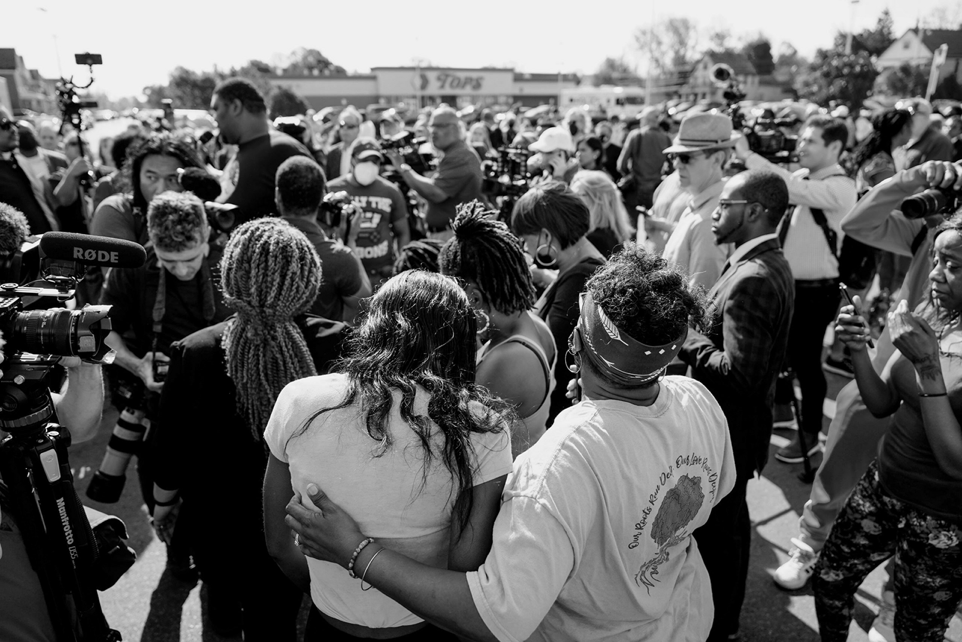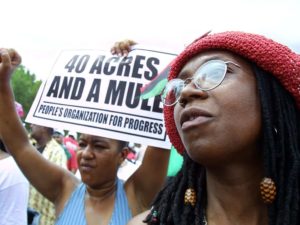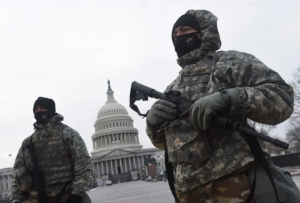The gunman seems motivated by a vision of history, pushed by the right, in which American racism never existed and Black people are undeserving takers.
On Saturday, in the parking lot of a neighborhood grocery store, an eighteen-year-old armed with a semi-automatic assault rifle, the N-word emblazoned on its front sight, began shooting. Shots cracked in the air, piercing through an unusually warm eighty-degree spring afternoon in Buffalo, New York. The teen-ager, who was later identified by the police, donned military-esque camouflage, was draped in body armor, and wore a camera to capture his bloody rampage. When the shooting stopped, thirteen people had been hit, ten of them killed. Eleven of those shot were Black. The gunman was captured by the police when he left the grocery store, and, by late Saturday night, he was arraigned on charges of first-degree murder.
The shooter is alleged to have posted a hundred-and-eighty-page “manifesto” avowing white-supremacist beliefs. In the hate-filled text, he denounced immigrants and Black people as “replacers” of white people. The notion that white people are being replaced has recently moved from the fringe of far-right politics to mainstream Republican Party politics. The Fox News personality Tucker Carlson has helped to popularize the ideology, and it has dovetailed seamlessly with the rhetoric of the Republican Party, which has insisted on describing the arrival of migrants at the southern border—seeking entry into the U.S. as asylum seekers—as an “invasion.”
The shooter rationalized his vicious attack by trying to fit it into this grand, esoteric conspiracy of white replacement through immigration. His manifesto, by contrast, is filled with crudely racist memes about Black Americans. In fact, for all his denunciation of “replacers” in the manifesto, an archive of his posts on the messaging platform Discord, from the past six months, barely mentions immigrants. Instead, he writes prolifically and disparagingly about Black people, whom he incessantly describes with racial slurs. In a search of archived posts beginning in 2021, the word “immigrant” appears twelve times, “replacement” eighteen times, “replacer” twenty-two times, but “blacks” and the N-word each appear a hundred times.
The manifesto seems intended to confer a sense of intellectual sophistication on his savage act. But the shooter’s Discord posts are full of sophomoric, even banal stereotypes about Black people—as genetically inferior, as predisposed to crime. The shooter claims inspiration from the white supremacist who murdered fifty-one worshippers at a mosque in Christchurch, New Zealand, in 2019. The Christchurch shooter also recorded his massacre and left a manifesto. But, for all of the Buffalo shooter’s professed inspiration from the Christchurch massacre, his actions seem to flow primarily from homegrown resentments. He searched by Zip Code for the largest Black population close to where he lived, in order to “kill as many blacks as possible.” His research led him to a grocery store, on the city’s East Side, along the Jefferson Avenue commercial corridor, running through the heart of Black Buffalo.
Once startling and noteworthy, mass shootings have melded into the background of life in the U.S. Since January, there have been almost two hundred shootings involving at least four victims shot or killed, according to the Gun Violence Archive. A recent report published by the C.D.C. showed that, from 2019 to 2020, the over-all homicide rate involving a firearm rose by nearly thirty-five per cent. The Buffalo massacre stands out not only because of the number of people killed but because of the political nature of the assault. This must be viewed within the context of the growing normalization of racism and political violence in the U.S. If Dylann Roof, the white racist who killed nine Black parishioners at the Emanuel African Methodist Episcopal Church in June of 2015, helped to inaugurate the racial grievance at the core of the Trump Presidency, then the Buffalo shooter’s killing spree may be emblematic of its still rippling effects. Roof, whom the Buffalo shooter acknowledges in his manifesto as a “freedom fighter,” also penned a manifesto full of deranged ideas, linking Black crime with the decline of white life in the U.S.
THE DAILY
The best of The New Yorker, every day, in your in-box.
In his manifesto, the Buffalo shooter writes, “Blacks are the most privileged race in the US and many western countries. But yet they say they are the most oppressed. What other race is given trillions of dollars of White taxpayer money to succeed, but yet fails and asks for more? What other race actively destroys their communities like they do?” The comments do not sound very different from those made by former President Trump, who tweeted in the summer of 2019, of the late African American congressman Elijah Cummings’s majority-Black Baltimore district, “Why is so much money sent to the Elijah Cummings district when it is considered the worst run and most dangerous anywhere in the United States. No human being would want to live there. Where is all this money going? How much is stolen?” and “Cumming District is a disgusting, rat and rodent infested mess. If he spent more time in Baltimore, maybe he could help clean up this very dangerous & filthy place.”
Trump coddled avowed white supremacists during his Presidency, and his open stoking of racial animus unshackled the Republican Party from norms long held in mainstream politics. One day prior to Roof’s mass murder, Trump announced his candidacy for President in New York City and called Mexican immigrants “rapists.” When white supremacists marched through Charlottesville, Virginia, in the summer of 2017, screaming “Jews will not replace us,” Trump claimed that some of the demagogues were “very fine people.” Before the Christchurch shooter carried out his massacre, in 2019, he hailed Trump as a “symbol of renewed white identity and common purpose.” The President called the attack “horrible” but downplayed the threat of white nationalism in the same breath. Throughout 2020, as historic protests against racism unfolded, and an election loomed, the Republican Party continued to court its right-wing fringe. Seventeen-year-old Kyle Rittenhouse menaced a Black Lives Matter protest in Kenosha, Wisconsin; armed with an AR-15-style semi-automatic rifle, killed two unarmed men; and overnight became a celebrity within the Republican Party. Trump defended Rittenhouse; Wisconsin’s Republican senator, Ron Johnson, also refused to condemn him. Rittenhouse was eventually acquitted of first-degree-homicide charges, last November, and remains a hero on the right. During the assault on the Capitol, on January 6, 2021, extremists and the mainstream Republican Party came together in an act of violence intended to overturn the results of the election. This marked a dangerous turning point in U.S. politics, when it became clear that, for the right, anything was on the table when it came to preserving political power.
As the protests of 2020 receded into the background, Republicans went on the offensive. One of Trump’s last initiatives in office was the formation of the 1776 Commission, undertaken as a rebuke to the New York Times’ 1619 Project. “The crusade against American history is toxic propaganda, ideological poison, that, if not removed, will dissolve the civic bonds that tie us together. It will destroy our country,” he said. This has since evolved into a generalized strategy, intended to shift the conversation away from systemic racism, voting rights, and police reform, and toward a fight over critical race theory. As the culture warrior Christopher Rufo, of the Manhattan Institute, put it:
This effort was largely successful in shifting attention away from the patterns of deep-seated racism revealed by the pandemic and by the brutal public lynching of George Floyd. Instead, there has been a frenzy of legislation sharply limiting the ways that slavery, and other aspects of America’s racist history, can be discussed in schools—or whether they can be discussed at all. According to Education Week, seventeen states have signed into law bans or restrictions on teaching “critical race theory” or racism and sexism, and twelve more are considering such legislation. There have also been efforts to ban books, such as Toni Morrison’s “The Bluest Eye,” and, the Times reporter Nikole Hannah-Jones’s work, the 1619 Project. School-board meetings have turned into forums for political theatre that emphasizes the grievance of white parents and denies the realities of racial discrimination. This spring, Florida’s governor, Ron DeSantis, signed into law the Stop Wrongs to Our Kids and Employees (WOKE) Act, which restricts the ways that businesses and public schools, including universities, can train or teach about racism, in order to avoid exposing white people to feelings of guilt. This effort has been bolstered by the enthusiasm of a new generation of right-wing officials, including Representative Paul Gosar, of Arizona, who attended a February gathering of white nationalists, and Wendy Rogers, a Republican state senator in Arizona who promotes the idea that white people are being replaced and recently insinuated that the Buffalo massacre was a “false flag” event, instigated by federal agents.
These collective efforts have made a mockery of public conversations about the history of American racism and xenophobia—and, in some contexts, have made them all but impossible. Discussions of America’s racist history lend important insights into the patterns of poverty, unemployment, and social deprivation that exist today. They underlie the arguments for the creation or expansion of public programs intended to alleviate racial exclusion. Without this context—evaded even by some liberals afraid of being tagged as favoring “big government” and actively suppressed by the right—the Buffalo shooter’s notion, rendered euphemistically in mainstream Republican discourse, that Black people are undeserving takers, becomes a kind of common sense.
These national political machinations have local repercussions. The neighborhood where the shooting took place, Masten, is overwhelmingly Black, with many people living below the poverty line. I spoke with Pastor George F. Nicholas, of the Lincoln Memorial United Methodist Church, which is situated in the area. “I had two families that were directly impacted by what happened yesterday,” he said. “And I let those family members share. And then others who, unbeknownst to me, had friends or people who they were connected to that lost their lives yesterday. They shared, and then I just gave people the moment of opportunity to talk about what they were going through. . . . Many people were angry. That was a big sentiment. Angry that it happened. Angry that it didn’t have to happen. Angry at the ability of our society to really, fully comprehend or to acknowledge the historical roots that drive these things.” He saw the violence as a continuation of the broader disenfranchisement that Black people in Masten experience. “The high poverty rates, the poor health outcomes or academic outcomes don’t just happen. Those are the direct results of policy decisions and investment decisions that have been made. And, you know, if communities are not perceived as having much value, and the people who live in them are perceived as not having much value . . .”
Nicholas’s voice trailed off, but the point was clear. For decades, Black life has been seen as disposable. Buffalo is one of the poorest cities in the nation, and the poverty is concentrated in the neighborhoods with the largest Black populations. Racism there comes not only in the form of a teen-age white supremacist murdering Black people at a grocery store. It is also evident in the policies that encourage disinvestment from public schools attended by Black students, in the annual failure to develop affordable-housing policies, and in the continued use of fees and fines that disproportionately impact Black residents. At a vigil on Sunday near the site of the massacre, hundreds gathered to honor the dead. The Reverend Denise Walden-Glenn spoke to the crowd and implored them to go beyond decrying this racist attack to address these long-standing inequities in Black Buffalo. “It was an eighteen-, nineteen-year-old boy who came up here, and his heart was so full of hate that he came to kill us,” she told the crowd. “Someone knew enough to enter the one store that we have here to shatter our world and devastate our community. While we are talking about increasing the police budget by $5.4 million, we need to talk about where to invest that money into our communities and our people.”
The conservative hysteria that seeks to envelop American history in a shroud of innocence and ignorance—and thus refuses to acknowledge the roots of racial inequality, residential segregation, underemployment—is a convenient justification for never having to use the power of the state to address these issues. It also perpetuates the delusion that segregation is a choice and that Black neighborhoods suffer greater inequities because of something intrinsic to the people who live in these communities. This is not just wrong; it is dangerous. And, on an otherwise warm Saturday afternoon, a shooter stepped out of the darkness and showed us what happens when we continue to hide from our history.




